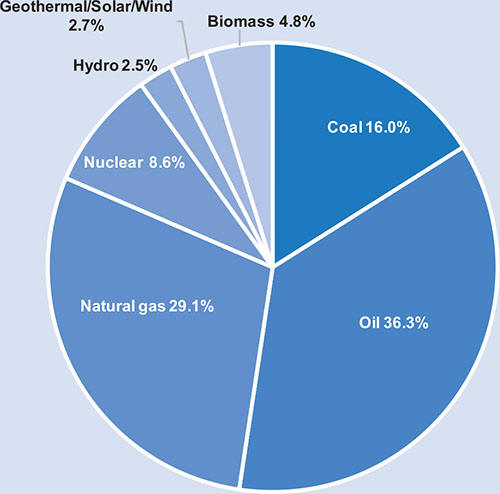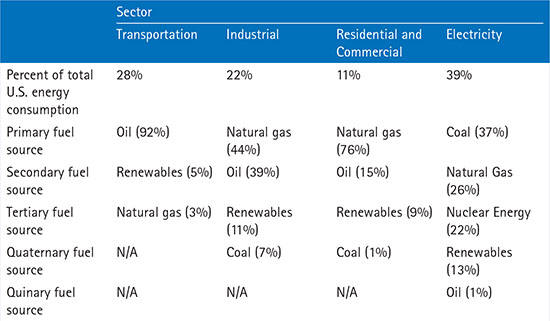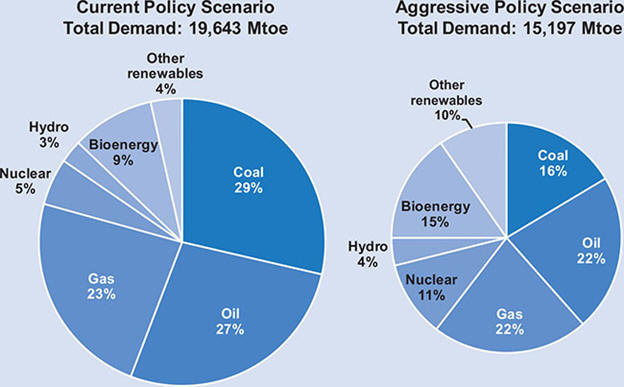|
II. Natural Resource Economics
A. Energy
1. Energy consumption
.
| Global Energy Consumption 2013 |
U.S. Energy Consumption 2014 |
 |
 |
.
2. Criteria for evaluating energy sources
a. Price
.
b. Availability
.
c. Environmental impacts
-
Look at impact over the full life-cycle:
extraction, use, waste products, decommissioning of facilities
.
d. Net energy

.
e. Suitability
-
Different types of energy more useful for
certain applications
-
Use sectors - transportation, industrial,
residential and commercial (non-electricity), electricity
U.S., 2015

.
3. Energy trends
-
World energy demand has grown rapidly and
will continue to grow in future
-
Expanded use of all forms of energy
-
Most rapid growth in recent years in
non-hydro renewables
-
Solar and wind still a small share of global
energy supplies
-
Coal use was the most significant source of
meeting increased global energy demand between 2000 and 2015
-
Policy choices can impact consumption and
supply mix

.
4. Fossil fuels
.
a. Oil
-
High energy density and ease of storage
makes it ideal for transportation
-
"Peak" oil - limited supplies would lead to
increasing prices and reduced consumption
-
Unconventional sources (hydraulic fracturing
of rock, extraction from tar sands and oil shales) lead to increased
supply and falling prices
-
Hubbert curve
.
.
.
.
.
.
.
.
.

.
- Environmental impact of unconventional sources
is higher
b. Natural gas
-
Can be burned, also used directly to fuel
vehicles
-
More abundant than oil globally and in the
U.S. - 50 year supply at current levels of demand
-
Cleanest of the fossil fuels
- Concern about the environmental impacts of
fracking
.
c. Coal
-
Burned to generate electricity
-
Most abundant fossil fuel - 114 year supply
at current levels of demand
-
Most environmentally damaging of the fossil
fuels
- Particulate matter pollution due to burning
- Emits more carbon dioxide per unit of energy
.
5. Renewable energy sources
a. Availability
- Solar - southwestern U.S., northen Africa,
Middle East, parts of Australia and South America
- Wind - northern Europe, southern tip of South
America, Great Lakes region of U.S.
- Geothermal - Iceland, the Philippines

.
b. Renewable energy infrastructure
-
System that supports the use of renewable
energy
-
Technology for plants / devices already
exists, needs to be deployed

.
-
Upgrades to the electrical grid, new
capacity to store and transfer power
-
Land, including land in-between wind
turbines
.
c. Intermittency
- Wind - depends on wind speed
- Solar - varies by time of day, affect by
cloudy weather
-
Renewables have low capacity factors
compared to fossil fuels
-
Problems with supply / demand matching,
particularly for electricity
- Output cannot be increased on demand
(1) Energy diversity - solar strongest in
summer, wind strongest in winter
(2) Storage - batteries, pumped water
storage
(3) Robust national electric grid - move
energy from where it is produced to where it is needed
.
6. The economics of alternative energy
futures
a. Cost
Ex. - Nuclear power plant
Ex. - Coal power plant

-
Natural gas cheapest
-
Onshore wind, hydroelectric competitive
-
Cost of solar and wind expected to fall in
future, become less variable
.
b. Subsidies
(1) Direct payments
.
(2) Favorable loans
.
(3) Tax credits and deductions
-
Taxes reduced for actions taken, e.g.,
installing insulation, purchasing fuel-efficient vehicle
-
Depletion
allowance - tax deduction for investments used to extract
natural resources, especially oil and gas
.
(4) Price supports
.
(5) Mandated purchase quotas
-
Minimum purchases of some resources required
-
Ex. - Gasoline must have a certain
percentage of ethanol, governments buy a certain percentage of
energy from renewable sources
.
-
Most subsidies go to fossil fuels, both for
electricity generation and for transportation
-
Subsidies appropriate if positive
externalities exist - fossil fuels usually generate negative
externalities
-
Price-Anderson
Act - limits liability of nuclear power plant operators
-
Subsidies for renewable energy large on a
per-kilowatt-hour basis
- Wind (7 cents), concentrated solar (29 cents),
solar photovoltaic (64 cents)
.
c. Environmental externalities
.
.
.
.
.
.
.
.

.
7. Policies
a. Reduce fossil fuel subsidies
.
b. Taxes to internalize negative
externalities
.
c. Energy research and development
.
d. Feed-in tariffs
-
Guarantee renewable energy producers access to electricity grids
-
Long-term price contracts
-
Should be phased out as renewable sources
become more competitive
.
e. Subsidies for renewable sources
-
Direct payments, tax credits, low-interest
loans
-
Makes more sense for developing, rather than
mature technologies
-
Can lead to economies of scale
.
.
.
.
.
.
.
.
f. Renewable energy targets
.
g. Efficiency improvements and standards
- Most
most cost effective and environmentally beneficial
- Ex. - Fuel standards, buildings, appliances,
light bulbs
Ex. -
.
|


